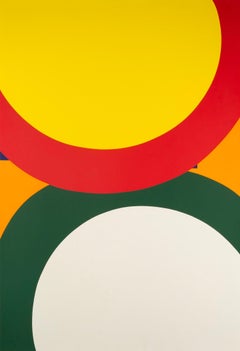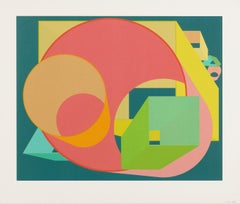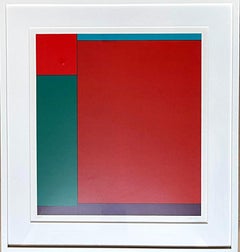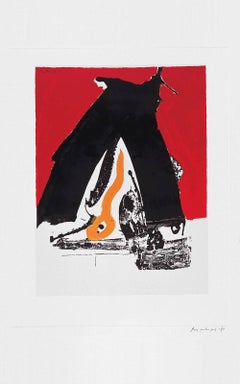Al Held More Prints
American, 1928-2005
Alvin Jacob Held, (1928-2005) Al Held earned his slot in the annals of American contemporary art with his bold, geometric canvases that took abstraction to another level. His free-floating, interlocked cubes, and planes invited the viewer into a vertigo-inducing landscape that seemed to stretch on into infinity. "Immense architectural structures curve and slice through these complex paintings, often enmeshing themselves in cellular structures," noted the Times of London. "Viewers felt that they were exploring some mysterious universe, and Held never lost his passionate belief in abstract painting's ability to create a sublime new world."
Held grew up in Brooklyn, New York, and as a teenager, missed so many days of high school that it was suggested he consider leaving altogether. He eventually earned a night-school diploma, and spent two years in the U.S. Navy. Back in New York City, he enrolled in classes at the Art Students League, and went on to study at the Académie de la Grande Chaumière in Paris in the early 1950s. The first solo exhibition of his work was staged there, in 1952 at the Galerie Huit. Held's abstract work took on a more orderly, formal tone, aided by a switch from oil to acrylic paints in 1959, and he had his first solo show in New York City that same year at the Poindexter Gallery. "Finessing the gap between Minimalism and Color Field painting," wrote New York Times journalist Ken Johnson of the next decade of Held's career, "he produced smooth, simplified works based on enlarged letters of the alphabet. And in the late '60s and '70s he made complex black-and-white pictures of sharply outlined cubes, pyramids, and other geometric shapes floating in illusory spaces of indeterminate depth."
Some of Held's best-known works are those floating black and white cubes, a series he began in 1967. One of the largest, which stretches more than 90 feet in length, was installed at the Empire State Plaza in Albany, New York. In the late 1970s, in an abrupt shift, he began using color again, and the geometric shapes became so precise that they were sometimes mistaken for computer-generated art. Held considered his images not unlike those of religious art, once telling an interviewer that "historically, the priests and wise men believed that it was the artist's job to make images of heaven and hell believable, even though nobody had experienced these places," he said, according to his Chicago Tribune obituary.
Held spent 20 years teaching at Yale University's. Represented by the Robert Miller Gallery in New York City, which staged what would be his last exhibition of new work in 2003, Held's works were avidly sought by contemporary-art enthusiasts around the world, and were part of the permanent collections of many institutions, including the Metropolitan Museum of Art and the Museum of Modern Art.
— Carol Brennanto
2
Overall Width
to
Overall Height
to
2
16
697
454
230
172
2
1
1
2
1
1
1
1
Artist: Al Held
Untitled - 20th Century Brightly Colored Print, Yellow, Red, Green + Grey Circle
By Al Held
Located in Kingsclere, GB
Born in Brooklyn in 1928 to Polish immigrants, Al Held claims to have been expelled from high school in the Bronx in 1944. After serving in the U.S. Navy from 1945 to 1947, Held asso...
Category
20th Century Abstract Expressionist Al Held More Prints
Materials
Screen
Scholes I
By Al Held
Located in New York, NY
This screenprint was created by the artist in 1991. Signed in pencil and numbered from the edition of 80 measuring 29 x 34 in. (73.7 x 86.4 cm.). Published by The Metropolitan Museu...
Category
20th Century Abstract Geometric Al Held More Prints
Materials
Screen
Price Upon Request
Related Items
Geometric Abstraction Color field silkscreen signed Artists Proof, Museum Frame
By Ludwig Sander
Located in New York, NY
LUDWIG SANDER
Untitled geometric abstraction
Artists Proof, aside from the regular edition of 90
Hand signed and annotated AP on the front
Elegantly matted and framed in white wood m...
Category
1970s Abstract Geometric Al Held More Prints
Materials
Screen
$3,000
H 31 in W 28.5 in D 2.25 in
The Basque Suite: Untitled
By Robert Motherwell
Located in London, GB
Edition of 150
104.1 x 71.7 cms (41 x 28 1/4 ins)
Category
1970s Abstract Expressionist Al Held More Prints
Materials
Screen
Lines & Color, Straight, Not-Straight and Broken Lines, Using All Combinations..
By Sol LeWitt
Located in Milford, NH
A colorful geometric silkscreen print by American artist Sol LeWitt (1928-2007). LeWitt was born in Hartford, Connecticut, and attended Syracuse University where he studied tradition...
Category
1970s Abstract Geometric Al Held More Prints
Materials
Paper, Screen
$1,950
H 32.88 in W 32.88 in D 1.5 in
Untitled from "Kinderstern" - Max Bill, Hard Edge, Color Field, Bright Colors
By Max Bill
Located in Köln, DE
Screenprint by Max Bill. From the portfolio "Kinderstern".
No Title, 1989
76 x 58 cm
Copy 61/100
Edition of 100 (approx.)
Category
1980s Abstract Geometric Al Held More Prints
Materials
Screen
$2,378
H 29.93 in W 22.84 in
Untitled, from the Kinderstern Portfolio
By Sol LeWitt
Located in Milford, NH
A fine black and white silkscreen geometric print from the Kinderstern Portfolio by American artist Sol LeWitt (1928-2007). LeWitt was was born in Hartford, Connecticut, and attended...
Category
1980s Abstract Geometric Al Held More Prints
Materials
Paper, Screen
The Basque Suite #6
By Robert Motherwell
Located in New York, NY
A very good impression of this color screenprint on J. B. Green paper. Initialed and numbered 96/150 in pencil by Motherwell. Printed by Kelpra Studio, London. Published by Marlborou...
Category
1970s Abstract Expressionist Al Held More Prints
Materials
Color, Screen
Elegy, September 11, 2001, screenprint, signed/N, Framed abstract expressionist
By Jules Olitski
Located in New York, NY
Jules Olitski
Elegy, September 11, 2001, 2002
Silkscreen on wove paper
Edition 103/108
Signed, titled and numbered in graphite pencil 103/108 on the front
Framed
Jules Olitski is hon...
Category
1980s Abstract Expressionist Al Held More Prints
Materials
Screen
$4,000
H 34 in W 44 in D 1 in
"Homage to the Square: Ten Works by Josef Albers" - Abstract, Set, Square
By Josef Albers
Located in Köln, DE
Set of 10 colour screenprints by Josef Albers.
Edition of 250 copies on Mohawk Superfine Bristol.
Sheet dimensions each: 43 x 43 cm
Illustrations each: 28 x 28 cm
All works labell...
Category
1960s Abstract Geometric Al Held More Prints
Materials
Screen
$66,058
H 16.93 in W 16.93 in
Chrome Green
By Adolph Gottlieb
Located in New York, NY
A very good impression of this color screenprint on Arches. Signed, dated and numbered 125/150 in pencil by Gottlieb. Printed by Kelpra Studio, London, with the ink stamp verso. Publ...
Category
1970s Abstract Expressionist Al Held More Prints
Materials
Color, Screen
Expo 1970 World Exhibition in Osaka – Original Vintage Japanese Poster
By Yusaku Kamekura
Located in Zurich, CH
Original Vintage Event Poster created 1967 by one of the best known Japanese graphic artists, Yusaku Kamekura; in 1960 he was a founding member, then ...
Category
Mid-20th Century Abstract Geometric Al Held More Prints
Materials
Paper
$1,670
H 40.75 in W 28.75 in D 0.04 in
The Basque Suite #2
By Robert Motherwell
Located in New York, NY
A very good impression of this color screenprint on J. B. Green paper. Initialed and numbered 134/150 in pencil by Motherwell. Printed by Kelpra Studio, London. Published by Marlboro...
Category
1970s Abstract Expressionist Al Held More Prints
Materials
Color, Screen
The Basque Suite: Untitled
By Robert Motherwell
Located in London, GB
Colour screenprint on J.B. Green paper
104.1 x 71.7 cms (41 x 28 1/4 ins)
Edition of 150
Category
1970s Abstract Expressionist Al Held More Prints
Materials
Color, Screen
Al Held more prints for sale on 1stDibs.
Find a wide variety of authentic Al Held more prints available for sale on 1stDibs. If you’re browsing the collection of more prints to introduce a pop of color in a neutral corner of your living room or bedroom, you can find work that includes elements of orange and other colors. You can also browse by medium to find art by Al Held in aquatint, etching, screen print and more. Much of the original work by this artist or collective was created during the 20th century and is mostly associated with the abstract style. Not every interior allows for large Al Held more prints, so small editions measuring 34 inches across are available. Customers who are interested in this artist might also find the work of Leon Polk Smith, Roy Ahlgren, and Robyn Denny.



